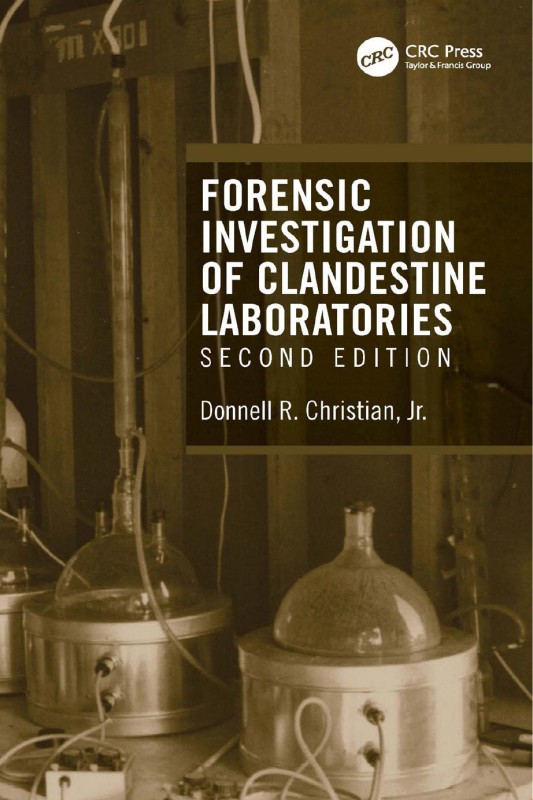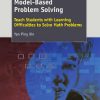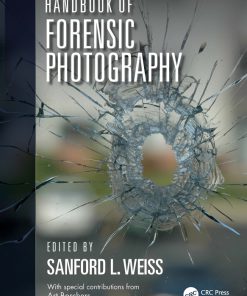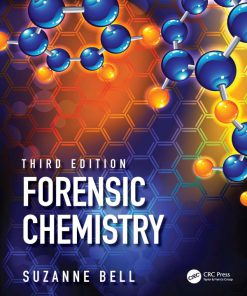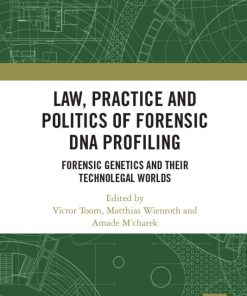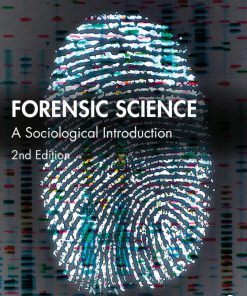(Ebook PDF) Forensic Investigation of Clandestine Laboratories 2nd Edition by Donnell Christian 1000594300 9781000594300 full chapters
$50.00 Original price was: $50.00.$25.00Current price is: $25.00.
Authors:Donnell R. Christian , Series:Forensic [25] , Author sort:Christian, Donnell R. , Ids:DOI , Languages:Languages:eng , Published:Published:Apr 2022 , Publisher:CRC Press , Comments:Comments:This second edition is fully updated to address all aspects of the forensic investigation of clandestine laboratories. Coverage looks at domestic clandestine manufacture of contraband substances in addition to expanding the scope to investigating the clandestine manufacture of explosives.
Forensic Investigation of Clandestine Laboratories 2nd Edition by Donnell R. Christian – Ebook PDF Instant Download/DeliveryISBN: 1000594300, 9781000594300
Full download Forensic Investigation of Clandestine Laboratories 2nd Edition after payment.
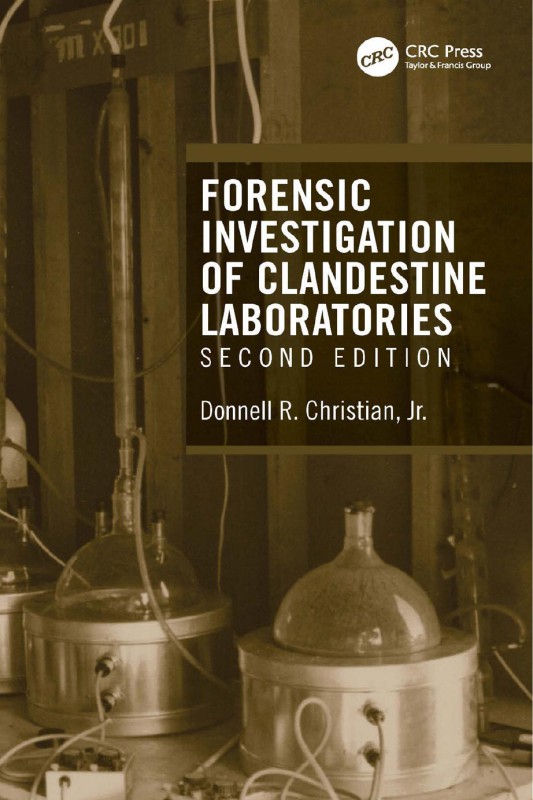
Product details:
ISBN-10 : 1000594300
ISBN-13 : 9781000594300
Author : Donnell R. Christian
Forensic Investigation of Clandestine Laboratories, Second Edition is fully updated to address all aspects of the forensic investigation of clandestine laboratories. While, the first edition focused on the domestic clandestine manufacture of contraband substances, this edition expands the scope to more fully address the clandestine manufacture of explosives that have become a threat that is global in nature. In clandestine laboratory operations, equipment is often simple, household chemical products are utilized, and the education of the operators basic. In fact, most of the time these elements individually are perfectly legal to sell and possess. However, the combination of all these elements is what becomes the scene of illicit activity and a criminal operation. In response to the increase in use of homemade explosive mixtures by terrorists, both domestically and internationally, the section clandestine manufacture of explosives is greatly enhanced.
Forensic Investigation of Clandestine Laboratories 2nd Table of contents:
1 Basics of Clandestine Manufacture
Abstract
1.1 Introduction
1.2 Lab Operators
1.3 Manufacturing Processes
1.3.1 Extraction Process
1.3.2 Conversion Process
1.3.3 Synthesis Process
1.3.4 Tableting/Compounding
1.3.5 Combination Labs
1.4 Needs Triangle
1.4.1 Equipment Needs
1.4.1.1 Reflux
1.4.1.2 Distillation
1.4.1.3 Hydrogenation
1.4.1.4 Bucket Chemistry
1.4.1.5 Extractions
1.4.1.6 Compounding
1.4.2 Chemical Needs
1.4.3 Knowledge Needs
1.5 Practical Examples
1.5.1 Extraction Lab Example 1
1.5.2 Extraction Lab Example 2
1.5.3 Conversion Lab Example 1
1.5.4 Conversion Lab Example 2
1.5.5 Conversion Lab Example 3
1.5.6 Synthesis and Extraction Example
1.5.7 Distillation Example 1
1.5.8 Distillation Example 2
1.5.9 Distillation Example 3
1.5.10 Extraction and Separation Example
1.5.11 Filtration Example
1.6 Summary
2 Clandestine Lab Hazards
Abstract
2.1 Introduction
2.2 General Hazards
2.2.1 Little Training
2.2.2 Makeshift Operations
2.2.3 No Two Labs Are Alike
2.3 Hazard Priority
2.3.1 Explosion
2.3.2 Fire
2.3.3 Firearms
2.3.4 Exposure
2.3.5 Chemical Hazards
2.3.6 Physical Hazards
2.4 Hazard Abatement
2.5 Practical Application
2.5.1 Mechanical Explosions
2.5.2 Mechanical Explosions
2.5.3 Vapor Explosions
2.5.4 Compressed Gas Hazards (Example 1)
2.5.5 Compressed Gas Hazards (Example 2)
2.5.6 Compressed Gas Hazards (Example 3)
2.6 Summary
3 Basic Toxicology
Abstract
3.1 Introduction
3.2 Entry Routes
3.2.1 Inhalation
3.2.1.1 Absorption Rate
3.2.2 Dermal Absorption
3.2.3 Ingestion
3.3 Modes of Action
3.4 Influences on Toxicity
3.4.1 Length of Exposure
3.4.2 Degree of Exposure
3.4.3 Compound Factors
3.4.4 Exposure Factors
3.4.5 Personal Factors
3.5 Distribution and Elimination
3.6 Toxicity Measurements
3.6.1 Exposure Guidelines
3.7 Toxin Properties
3.7.1 Physical States
3.7.2 Toxic Properties
3.8 Personal Protective Equipment (PPE)
3.8.1 Eye Protection
3.8.2 Gloves
3.8.3 Clothing
3.8.4 Respiratory Protection
3.8.5 Levels of Protection
3.9 Summary
4 Scene Processing
Abstract
4.1 Introduction
4.2 Training
4.3 Seizure Stages
4.3.1 Planning
4.3.2 Briefing
4.3.3 Entry/Arrest
4.3.4 Hazard Evaluation/Abatement
4.3.5 Site Control
4.3.6 Personal Protective Equipment (PPE)
4.4 Scene Processing
4.4.1 Planning
4.4.2 Documentation
4.4.2.1 Photography
4.4.2.2 Videotape
4.4.2.3 Field Notes
4.4.3 Site Control
4.4.3.1 The Search
4.4.3.2 Inventory
4.4.3.3 Sampling
4.4.3.4 Field Testing
4.4.3.5 Disposal
4.5 Practical Application
4.5.1 Practical Example: Initial Crime Scene Evaluation
4.5.2 Practical Example: Training and Experience
4.5.3 Practical Example: Training and Experience
4.5.4 Practical Example: Sampling
4.5.5 Practical Application: Bottle Volume Estimates
4.5.6 Practical Application: Flask Volume Estimates
4.5.7 Practical Application: Separatory Funnel Volume Estimates
4.5.8 Practical Application: Reaction Flask Volume Estimates
4.5.9 Practical Application: Volume Estimate Accuracy
4.6 Summary
5 Laboratory Analysis
Abstract
5.1 Introduction
5.2 The Chemist
5.2.1 Single Chemist
5.2.2 Independent Analytic Chemist
5.2.3 Analytical Bias
5.3 Types of Analysis
5.4 Identification Requirements
5.5 Inorganic Analysis
5.5.1 Chemical Color Tests
5.5.2 Microscopic Techniques
5.5.3 Infrared Spectroscopy
5.5.4 Ion Chromatography
5.5.5 X-Ray Analysis
5.6 Organic Analysis
5.6.1 Test Specificity
5.6.2 Wet Chemical Procedures
5.6.2.1 Chemical Color Tests
5.6.2.2 Microscopic Techniques
5.6.2.3 Thin Layer Chromatography (TLC)
5.6.2.4 Extractions
5.6.2.5 Wet Chemical Documentation
5.6.3 Instrumental Examinations
5.6.3.1 Ultraviolet Spectroscopy
5.6.3.2 Gas Chromatography
5.6.3.3 Mass Spectroscopy
5.6.3.4 Infrared Spectroscopy
5.6.3.5 Documentation
5.7 Analytical Schemes
5.7.1 Solid Samples
5.7.2 Liquid Mixtures
5.7.2.1 Organic Liquids
5.7.2.2 Aqueous Liquids
5.7.3 Chromatographic Screening
5.7.4 Extractions
5.7.4.1 Physical Extraction
5.7.4.2 Dry Wash/Extraction
5.7.4.3 Liquid/Liquid Extractions
5.7.5 Isomer Determination
5.7.5.1 Microcrystal Examination
5.7.5.2 Derivatization
5.8 Quantitation
5.8.1 Microscopic Examination
5.8.2 Gravimetric Techniques
5.8.3 UV Techniques
5.8.4 GC Techniques
5.9 Practical Application
5.9.1 Data Interpretation
5.9.1.1 Practical Example 1
5.9.1.2 Practical Example 2
5.9.1.3 Practical Example 3
5.9.2 Extractions
5.9.2.1 Dry Extractions
5.9.2.2 Methamphetamine Extraction
5.9.2.3 Methamphetamine Extraction
5.9.2.4 Ephedrine/Pseudoephedrine Separation
5.9.2.5 Methamphetamine By-Product Profile Extraction
5.9.2.6 Black Powder Substitute Components
5.9.3 Practical Applications: Quantitation
5.9.3.1 Gravimetric Quantitation
5.9.3.2 Beer’s Law Extrapolation
5.9.3.3 Mathematic Calculation
5.9.3.4 Single Standard Calculation
5.10 Summary
6 Opinions
Abstract
6.1 Introduction
6.2 The Questions
6.2.1 Who?
6.2.2 What?
6.2.3 When?
6.2.4 Where?
6.2.5 Why?
6.2.6 How?
6.3 Information
6.3.1 Scene Information
6.3.2 Laboratory Analysis Information
6.3.3 Experience and Training
6.4 What? How? How Much?
6.4.1 What Is He Making?
6.4.2 How Is He Making It?
6.4.3 How Much …?
6.4.3.1 How Much Product?
6.4.3.2 How Much per Batch?
6.4.3.3 How Much per Week?
6.5 Practical Application
6.5.1 Practical Example (Knowledge and Experience)
6.5.2 Practical Example (Knowledge and Experience)
6.5.3 Practical Application (Information Interpretation)
6.5.4 Practical Application (Information Interpretation)
6.5.5 Practical Application (Data Interpretation)
6.5.6 Practical Application (Production Estimates)
6.5.7 Practical Application (Production Estimates, Multi-Step)
6.5.8 Practical Application (per Batch Production Estimates)
6.6 Summary
7 Presenting Results
Abstract
7.1 Introduction
7.2 Written Report
7.3 Oral Presentations
7.3.1 Verbal Presentations
7.3.1.1 Verbal Reports
7.3.1.2 Summary Briefs
7.3.2 Testimony
7.3.2.1 Case Preparation
7.3.2.2 Pretrial Conference
7.3.2.3 Testimony
7.3.2.4 Visual Aids
7.3.2.5 Types of Visual Aids
7.4 Practical Application
7.4.1 Practical Example: Terminology
7.4.2 Practical Example: Pretrial Preparation
7.5 Summary
8 Explosives Labs
8.1 Introduction
8.2 Explosives Lab Operators and Manufacturers
8.3 Regulations
8.4 Scene-Processing Procedures
8.5 Summary
People also search for Forensic Investigation of Clandestine Laboratories 2nd:
types of forensic investigation
examples of forensic investigation
what is forensic investigation
foreign clandestine labs
clandestine laboratory investigation
You may also like…
eBook PDF
(Ebook PDF) Forensic Chemistry 3rd edition by Suzanne Bell 042980444X 9780429804441 full chapters

